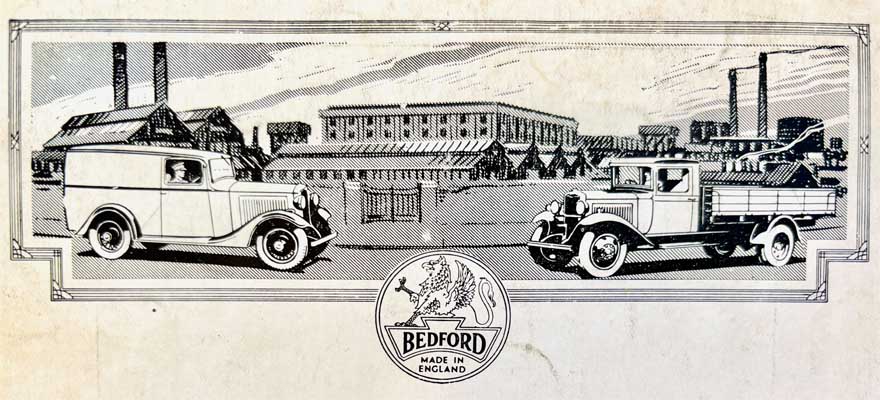
The History of Bedford trucks, lorries and buses.
The Early Years
The Bedford name was first used on General Motors vehicles in 1929 on the AC and LQ ‘Chevrolet Bedford’ Models. General Motors had been producing British Chevrolet vehicles which were manufactured in Canada and assembled in Brazil. This allowed the company to import the vehicles to countries inside the British Empire more freely. However in 1925 when GM gained ownership of Vauxhall Motors they moved their British Chevrolet manufacturing plant to Luton in Bedfordshire. It was at this new plant that the AC and LQ Chevrolet Bedford’s were produced taking the name from the nearby town of Bedford. The Chevrolet name was quickly dropped and the first Bedford’s were produced in April 1931.
The Second World War
Bedford continued manufacturing British lorries, buses, vans and ambulances, however in 1935 they began developing a 15cwt truck for the British War Office. This was the Bedford MW (a shorter wheel-based lighter version of the later, Bedford O Series) which had a wide range of roles including a general service truck, wireless truck, and water bowser. This started immediate service in 1939 and was at the time the only Bedford specifically designed for military use. At the outbreak of the second world war Bedford hastily ceased production of the K, M and O series redesigning the O Type for military use, producing the OX and OY and in 1941 the OW for essential civilian use during the war.
The next large development for Bedford came with the QL (Quadruple Locomotion) , a four wheel drive, forward control lorry which began service in 1941. The QL, similarly to the other military Bedfords, took on many roles including an artillery tractor, radio truck, petrol tanker, troop carrier, tipper, and most commonly, the QLD for general use.
Bedford were also producing the OB coach; the only single decker bus allowed to be produced during the war years. They also produced the Bedford twin-six flat-12 gasoline engine that was used in the Churchill tank, as well as manufacturing metal components for Frank Whittle’s top secret jet engine.
This range of vehicles started Bedford’s long legacy with the British Army.
Post War
After the war Bedford resumed production of the K, M and O Series until 1953 when they started production of the A type the forerunner to the D type and J type. The company also continued producing its HC and JC vans which in 1948, with a newly improved Vauxhall engine, became the PC. In 1952 Bedford launched its range of CA light commercial vehicles which were a range of vans, pickups and campervans which predated the similar iconic Ford Transit of 1965. The design had a short bonnet and was semi forward control with the rear of the engine partially underneath the cab. The Bedford CA continued production with minor improvements until 1969 when it was replaced by the Bedford CF. This van was less successful than the previous model because of the Ford Transits growing popularity.
During the 1950’s Bedford also launched its very successful S Type trucks. These larger and so called ‘Big Bedfords’ were the first to move the company into the 7 ton range. A year later saw the introduction of the four wheel drive version, the RL, this became iconic with the RLHZ Green Goddess derivative. The Green Goddess was used by the Auxiliary Fire Service until 2004 when it was finally decommissioned however some found new homes in African nations such as Kenya where they lacked a developed fire service. The Bedford RL was mainly for military use and the British and Commonwealth armies used the high ground clearance four by four from 1952 up until recent times. The Bedford RL was produced for 17 years and many were later used for civilian use after military service. Along side the S Type, Bedford produced the SB bus which was launched in 1950 and didn’t cease production until 1987. These became large sellers in: Australia, New Zealand, Pakistan, India and some African nations, as well as in the UK. The chassis and running gear of these coaches were also used as bases for specialised vehicles such as fire engines and mobile libraries. Bedford also produced many other coach chassis such as the VAL, VAM, VAS and the Y series.
In 1958 the Bedford TJ normal control was introduced, this would be the last of the normal control Bedford Trucks. It was available with a petrol or a diesel engine and because of its basic and easily accessible layout became very popular in developing countries as an export; because of this success it was still being produced by AWD Trucks into the 1990’s.
In 1959 the Bedford S Type range were replaced by the newly designed Bedford TK. The Bedford TK was very successful and was the main light commercial lorry used in the UK through the 1960’s and 70’s. The TK was also produced as a Scammell tractor unit, fire engine and many other applications. Later the TK was used as a bases for the Bedford MK and MJ models.
Bedford went on to produce other Bedford models, including the TL and TM. The company was bought by AWD trucks in 1987 and production continued until it went into receivership in 1992.
This is a brief history focusing mainly on the range of trucks covered by Vintage Military Vehicle Spares.
